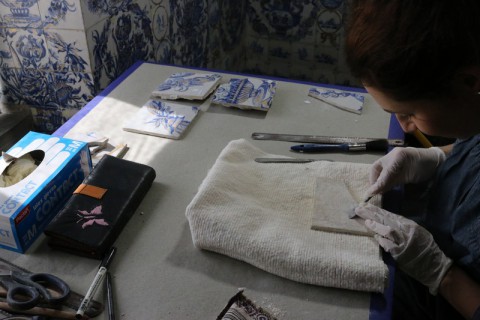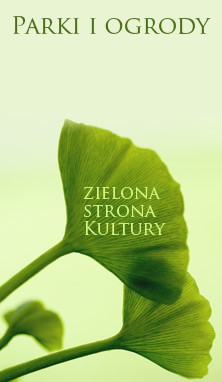Faience Cabinet
Wilanów's Faience Cabinet is unique in Europe as it features ceramics decoration of all the walls with almost 2,000 Dutch tiles. According to the latest research, this interior design dates back to the late 17th century, still during King Jan III's reign. This valuable cabinet is one of the best preserved baroque secular interiors in Poland and is regarded as one of the world's most beautiful rooms decorated with Dutch ceramic tiles.
The set of glazed white cobalt-decorated tiles was made using the majolica technique in Amsterdam and Utrecht workshops. The gilding on the tiles was probably made after they had been fixed to the walls.
The wall decorations were composed in the form of about 120 panels featuring bouquets of flowers in vases, surrounded by individual scenes with themes related to court life, shepherds, Bible, horsemen, sea creatures and landscapes.
Changes in the cabinet's artistic design and renovation work were carried out several times, for example in the early 19th century when the rooms on the palace's first floor were given a Chinese interior design, and in 1955-63, before the palace was made available to the general public. At that time the lintels were modernised twice, and during the great renovation of the palace in 1955-63 the cabinet's floor level was raised, thus obscuring a fragment of the lower band of tiles.
The most recent conservation and restoration works in 2014-15 were preceded by two-year-long interdisciplinary research. Among others, it covered the analysis of materials used, technological and microbiological analyses, inventory-taking of all the tiles and photographic documentation of the UV-induced luminescence, and it also involved the use of a thermal imaging camera and a ground-penetrating radar. At the same time, historical and iconographic studies were carried out in collaboration with Polish and Dutch researchers. They made it possible to prepare an adequate programme of conservation work.
Almost half of the ceramics decoration became detached from its base. The biggest damage could be observed around the windows and doors, in the corners of the room and near the floor.
The state of conservation of each tile was thoroughly documented by a team of conservators. The removal of about 300 most affected tiles was started only after a precise mapping of the damage to the cabinet's walls was complete. The tiles underwent a meticulous conservation process. While cleaning their reverse sides, the conservators discovered interesting historical markings made in the Dutch workshops that among others gave indications on the direction the floral panel tiles should be fixed. The base was strengthened and stabilised, and the tiles were re-fixed where they belonged. The grout was recreated and the gilding was delicately restored to highlight the aesthetic qualities.
Polish specialists reconstructed two missing bands of tiles under the sills of both windows using a faience-making technique that was as close as possible to the original one.
Cobalt decorations depicting sea creatures were painted on the restored tiles, and the central tiles feature a road sign with the year "2014".
The floor level has been restored to the state from before 1955, which uncovered the lowest, so-far unseen decoration area.
The comprehensive conservation and restoration work also covered the painting and moulding of the cove and the dome with a polychrome plafond.
The works were made possible thanks to the co-funding from the Ministry of Culture and National Heritage.
We invite you to see a FILM that shows the course and the outcomes of the project.
translation: LIDEX sp. z o.o.
Polecane

EPICO – The Preventive Conservation in palace-museums
The purpose of the research project EPICO (European Protocol In preventive Conservation) is to draw up a methodology for developing …

The renovation and conservation of the Pump House and its environs
The Pump House is located by Lake Wilanowskie where a 17th-century geometric Baroque garden and a 19th-century English landscape park …

European and Oriental laquerware
Oriental lacquer constitutes one of the methods of decorating surfaces made of wood, bamboo, ceramics and papier mâché. Obtained from …

The restoration, reconstruction and the preparation of copies of two vases with swan heads and nods
The fragments of two hanging vases with swan heads and nods are archaeological monuments found during excavation research, known only …

Conservation and restoration works in the Quiet Room
The Quiet Room is a room in the Wilanów Palace located directly above the King's Bedroom. The walls and vault …

Conservation and restoration works in the Three Windows Cabinet
The Three Windows Cabinet is a small room, located on the first floor of the main body of the Palace. …




















